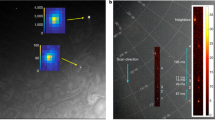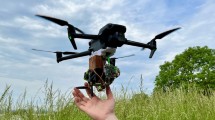Abstract
THE photograph of a group of meteor trails with a red glow beneath them shown in Fig. 1 was taken by an automatic camera from an altitude of 30.6 km at 0746 local time (2146 UT) at latitude 23° S, longitude 146° E, looking west, on November 11, 1968. The camera was an Olympus “PEN EM” half-frame 35 mm, set f/8 with an automatic exposure control. It was loaded with “Kodachrome II” colour reversal film, and it took a photograph of the horizon every 2 min in order to study dust layers in the stratosphere. It was mounted on the payload of a “Hibal” balloon operated by the Australian Department of Supply for the Health and Safety Laboratories of the Atomic Energy Commission of the United States.
This is a preview of subscription content, access via your institution
Access options
Subscribe to this journal
Receive 51 print issues and online access
$199.00 per year
only $3.90 per issue
Buy this article
- Purchase on Springer Link
- Instant access to full article PDF
Prices may be subject to local taxes which are calculated during checkout
Similar content being viewed by others
Author information
Authors and Affiliations
Rights and permissions
About this article
Cite this article
BIGG, E., THOMPSON, W. Daytime Photograph of a Group of Meteor Trails. Nature 222, 156–157 (1969). https://doi.org/10.1038/222156a0
Received:
Issue Date:
DOI: https://doi.org/10.1038/222156a0
This article is cited by
-
The fundamental role of giant comets in earth history
Celestial Mechanics and Dynamical Astronomy (1992)
Comments
By submitting a comment you agree to abide by our Terms and Community Guidelines. If you find something abusive or that does not comply with our terms or guidelines please flag it as inappropriate.



